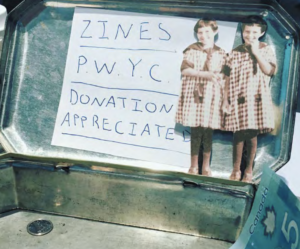Exposure Unit is a column about navigating the zine scene by Toronto-based zinester Rabeea Syed.
No one really likes to talk about money. But in this issue’s Exposure Unit, we’re going to look at it head-on. Specifically, money-related difficulties zinesters face.
People don’t make zines to get rich. Zines are a powerful way to put thoughts and feelings on paper, and their creation comes from a place of love. As far as art forms go, they’re considered affordable. But, we can’t ignore the initial costs, investments, and definitely the risks. If you self-publish, you need to produce copies at a cost lower than they’re sold. You might break even, but the profit margin is next to nothing.
Here’s where a crucial factor enters: the distribution of zines. For zinesters, there’s mainly one way to sell zines — you guessed it, zine fairs! This means travelling with your materials (taxi fares can add up!) and often coughing up a fair bit for the table fee. Once you’re at the fair, you’ve got to hope your audience is there, or that folks will notice you.
So there’s an economic dilemma here, especially for emerging and marginalized zinesters, for whom the stakes are higher. Established creators who already have money, resources, and recognition, are going to find the investment less risky, and perhaps find it easier to make zines a profitable practice in the long run.
However, don’t be discouraged. There are a few ways you can make the financial dilemma of zines easier on yourself. Often, finding access to resources is key. Personally, it’s cheaper to do risograph printing at my school than to go to a professional print shop, so I make a lot of zines there. If you (or a generous friend!) have access to a workplace or school, consider researching what resources they provide.
“Staples printing centres have been my friend,” says Noah Hurlbut, a zinester based in Halifax. “They have tools and materials that I don’t have at home, like staples, size-adjustable staplers, and slide cutters.”
Another way to help with costs can be trading services. Online trading is becoming widespread in Toronto and beyond (such as Bunz). If you offer a service, why not trade your services for another service? For example, I trade my skills as a designer for regular access to a button maker.
Buttons are a great way to make money in small sales, but a button maker is easily one of the more expensive tools a zinester could buy. Buttons and other small items can make for easy sales that add up. There are also a lot of great options for small zines. One-page folding zines are cost-effective, and the sales can add up.
As for tabling, don’t be afraid to talk to the organizers of the fair. A lot of zine fairs have a few tables available at a reduced rate and, trust me, they want to help you! Same goes with studio equipment and even printing. It requires bravery to ask for support, but it can pay off. In general, if you know someone who has access to resources that would be helpful for you to cut costs, talk to them about it. You might be surprised!
It’s unfortunate that zine culture, an alternative to mainstream corporate publishing, is restricted by finances. Money is hard. But let’s start talking about it. Maybe these tips will help at least a little. So, do what you can and make some zines with what you’ve got!
